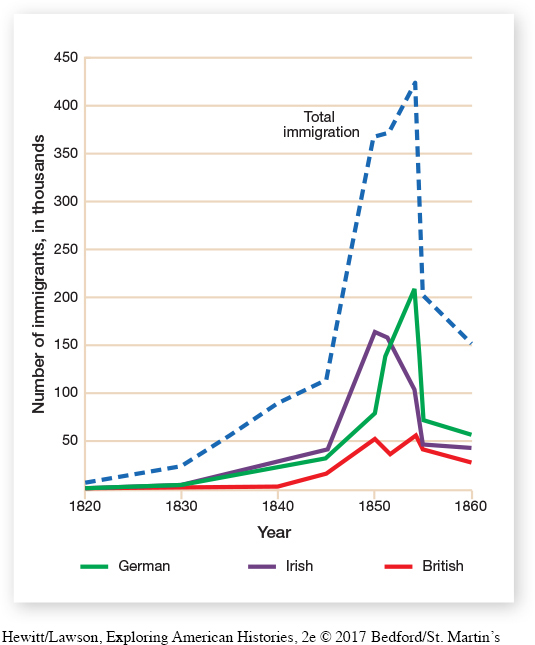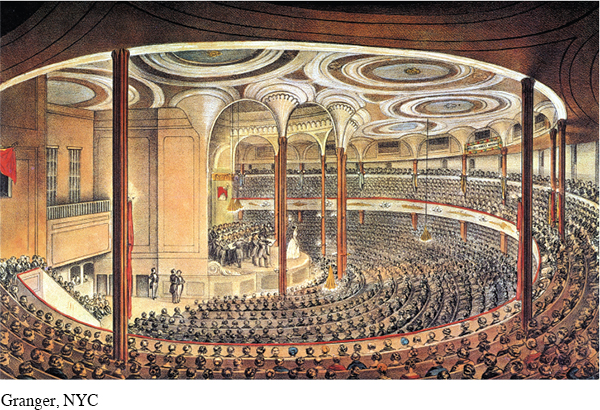The Lure of Urban Life
Across the North, urban populations boomed. As commercial centers, seaports like New York and Philadelphia were the most populous cities in the early nineteenth century. Between 1820 and 1850, the number of cities with 100,000 inhabitants increased from two to six; five were seaports. The sixth was the river port of Cincinnati, Ohio. Smaller boomtowns, like Rochester, New York, also emerged along inland waterways. Rochester grew rapidly once the Erie Canal was completed in 1825.
Cities increased not only in size but also in diversity. During the 1820s, some 150,000 European immigrants entered the United States; during the 1830s, nearly 600,000; and during the 1840s, more than 1,700,000. This surge of immigrants included more Irish and German settlers than ever before as well as large numbers of Scandinavians. Many settled along the eastern seaboard, but others added to the growth of frontier cities such as Cincinnati, St. Louis, and Chicago.
While many Scots-Irish Presbyterian families had settled in North America in the colonial era, Irish Catholics migrated in much larger numbers in the 1830s and 1840s. The Irish countryside was plagued by bad weather, a potato blight, and harsh economic policies imposed by the English government. In 1845 to 1846 a full-blown famine forced thousands more Irish Catholic families to emigrate. Young Irish women, who could easily find work as domestics or seamstresses, emigrated in especially large numbers. Poor harvests, droughts, failed revolutions, and repressive landlords convinced large numbers of Germans, including Catholics, Lutherans, and Jews, and Scandinavians to flee their homelands as well. By 1850 the Irish made up about 40 percent of immigrants to the United States, and Germans nearly a quarter (Figure 11.1).

These immigrants provided an expanding pool of cheap labor as well as skilled artisans who further fueled northern commerce and industry. Banks, mercantile houses, and dry-goods stores multiplied. Urban industrial enterprises included both traditional workshops and mechanized factories. Credit and insurance agencies emerged to aid entrepreneurs in their ventures. The increase in business also drove the demand for ships, commercial newspapers, warehouses, and other commercial necessities, which created a surge in jobs for many urban residents.
Businesses focused on leisure also flourished. In the 1830s theater became affordable to working-class families, who attended comedies, musical revues, and morality plays. They also joined middle- and upper-class audiences at productions of Shakespeare and contemporary dramas. Minstrel shows mocked self-important capitalists but also portrayed African Americans in crude caricatures. One of the most popular characters was Jim Crow, who appeared originally in an African American song. In the 1820s he was incorporated into a song-and-dance routine by Thomas Rice, a white performer who blacked his face with burnt cork.

The lures of urban life were especially attractive to the young. Single men and women and newly married couples flocked to cities. By 1850 half the residents of New York, Philadelphia, and other seaport cities were under sixteen years old. Young men sought work in manufactories, construction, and the maritime trades or in banks and commercial houses, while young women competed for jobs as seamstresses and domestic servants.
Exploring American HistoriesPrinted Page 350
Exploring American Histories Value EditionPrinted Page 259
Chapter Timeline